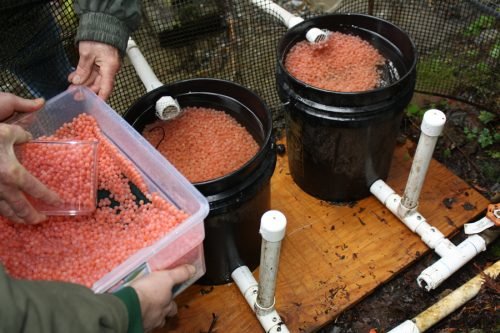 Stream water enters through an inflow pipe of a remote site incubator for salmon eggs, and then flows out through an outflow pipe at the top of the barrel back into the stream. A lid is secured on top of the barrel to protect young salmon and provide required darkness. Once hatched, alevin slip through their mesh egg trays to the substrate at the bottom of the barrel, where they absorb their yolk sac and become fry. The fry then exit the incubator at the barrel’s top outflow pipe into the stream. Courtesy Hood Canal Salmon Center
Stream water enters through an inflow pipe of a remote site incubator for salmon eggs, and then flows out through an outflow pipe at the top of the barrel back into the stream. A lid is secured on top of the barrel to protect young salmon and provide required darkness. Once hatched, alevin slip through their mesh egg trays to the substrate at the bottom of the barrel, where they absorb their yolk sac and become fry. The fry then exit the incubator at the barrel’s top outflow pipe into the stream. Courtesy Hood Canal Salmon Center
The Gig Harbor Commercial Fishermen’s Club has been collaborating with Minter Creek Hatchery for decades to bring chum salmon to local creeks.
Remote site incubators (RSIs) allow salmon to hatch in creeks where they may no longer spawn. Hatcheries provide eggs for the RSIs. The Washington Department of Fish and Wildlife developed the current model in the mid-1980s using 55-gallon barrels with trays that can hold up to 100,000 eggs. They trays are set up to ensure water flows over the eggs to supply oxygen and nutrients and to allow the fry to swim out to the creek. There, the fry will imprint on the stream and, if all goes well, will return as adults to spawn.
Chum salmon are especially well suited to RSIs since they quickly leave the streams to head to Puget Sound estuaries to continue to grow. Other species of salmon spend months in their home streams and if there are no adult spawned salmon bodies to provide nutrition, survival is more challenging.
Ed Manning, a longstanding member of the Gig Harbor Commercial Fishermen’s Club, has worked with two projects: one in Gig Harbor at Donkey Creek and the other at Purdy Creek.
He said the Donkey Creek project started in 1974. In January, club members collect up to a million eyed eggs—the stage of development where the eggs are clearly fertile and when the shell is tough enough to be shipped.
The eggs are placed in about a dozen RSIs in Donkey Creek. Manning said one of the hardest tasks is cleaning the RSIs in preparation for the eggs. Each day, someone checks to be sure that the water flow is good and that no debris from the creek has caused a problem.
Three months after the eggs are placed, the fish hatch and the fry swim out of the incubator to the creek and make their way to the harbor. A few years later, in November, they return. The return has been celebrated with the Annual Chum Festival since 2006.
The project at Purdy Creek is much smaller, Manning said. It started with a Peninsula High School project that is no longer active. About 15 years ago, Manning and a few friends scouted the creek, identified a good spot for an RSI and spoke to the landowners. They worked with the South Puget Sound Salmon Enhancement Group to get the incubators and eggs, and a few years later, about 20 fish returned. Now, with three incubators in place, the annual return is about 500 to 600 chum.
UNDERWRITTEN BY THE FUND FOR NONPROFIT NEWS (NEWSMATCH) AT THE MIAMI FOUNDATION, THE ANGEL GUILD, ADVERTISERS, DONORS AND PEOPLE WHO SUPPORT INDEPENDENT, NONPROFIT LOCAL NEWS